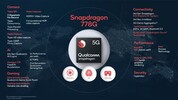Samsung Exynos 1380 vs Qualcomm Snapdragon 778G 5G vs Samsung Exynos 1480
Samsung Exynos 1380
► remove from comparison
The Samsung Exynos 1380 is a system on a chip (SoC) designed for mid-range smartphones and tablets running on the Android operating system. The CPU is made up of two clusters, each consisting of four cores. It features four Cortex-A78 performance cores (up to 2.4 GHz) and four Cortex-A55 power-saving cores (up to 2.0 GHz). The integrated graphics unit is an ARM Mali-G68 MP5 with speeds of up to 950 MHz.
The NPU's performance has been improved by around 14 percent compared to its predecessor, with a capacity of 4.9 TOPS. Displays with up to 144 Hz and Full HD+ resolution can now be used, and the chipset supports cameras with up to 200 MPix. The chipset also includes Wi-Fi 6 and Bluetooth 5.3. Both LPDDR4x and LPDDR5 can be used as RAM, and UFS 3.1 is possible as internal storage.
The integrated modem has significantly increased download speeds, supporting both 5G-Sub6 (download: up to 3.79 Gbps (+32%), upload: up to 1.28 Gbps) and 5G-mmWave (download: up to 3.67 Gbps (+75%), upload: up to 0.92 Gbps). The upload speed for LTE (Cat. 18, download: up to 1.2 Gbps, upload: up to 0.211 Gbps (+5%)) has only been slightly improved.
The Exynos 1380 is manufactured by Samsung using the 5-nm process.
Qualcomm Snapdragon 778G 5G
► remove from comparison
The Qualcomm Snapdragon 778G 5G (SDM778G 5G Mobile Platform) is a fast mid-range ARM-based SoC largely found on Android tablets and smartphones. It integrates eight cores (octa-core) divided into two clusters. A fast performance cluster with four cores based on the ARM Cortex-A78 architecture with up to 2.4 GHz and a power efficiency cluster with four small ARM Cortex-A55 cores at up to 1.8 GHz. Depending on the workload only single clusters or all cores can run at different clock speeds.
Thanks to the new Cortex-A78 cores, the CPU performance increases by up to 40% compared to the old Snapdragon 768G according to Qualcomm. In our benchmarks, the 778G is able to reach the performance of the old high end chip Kirin 990.
The integrated X53 5G modem supports up to 3.3 Gbps with sub 6Ghz. The FastConnect 6900 Wi-Fi modem supports the current Wi-Fi 6e standard with 6GHz.
The integrated Qualcomm Adreno 642L offers a 40% higher performance compared to the old Adreno 620 in the predecessor. This is partly thanks to the fast memory controller with LPDDR5-3200 support.
The integrated 6th gen AI engine called Hexagon 770 offers a 2x improvement and up to 12 TOPS of performance. The Spectra 570 ISP (image signal processor) supports up to three cameras. The satellite system supports all major standards like Beidou, Galileo, GLONASS and GPS.
The G specifies an optimized SoC for gaming and e.g. Qualcomm offers updates for the graphics driver.
The Snapdragon 778G is manufactured in the modern 6 nm process at TSMC (vs the 5LPE of the 780G).
Samsung Exynos 1480
► remove from comparison
The Samsung Exynos 1480 is a system on a chip (SoC) for mid-range smartphones and tablets based on Android. The CPU is made up of two clusters, each consisting of four cores. Four Cortex-A78 power cores (up to 2.75 GHz) and four Cortex-A55 power cores (up to 2.05 GHz) are used. The integrated graphics unit (GPU) is a Samsung Xclipse 530. The chipset supports Wi-Fi 6E and Bluetooth 5.3. Both LPDDR4x and LPDDR5 can be connected as RAM. UFS 3.1 is possible as internal memory.
The performance of the new AI engine with 6K MAC NPU is said to be around four times higher than its predecessor. In addition, displays with up to 144 Hz and Full HD+ can be used and cameras with up to 200 MPix are supported. The improved ISP now also enables videos in Ultra HD with up to 60 frames per second and is also capable of HDR and zero-shutter lag (ZSL).
The integrated modem has again received a significant speed boost for downloads and is considerably faster for both 5G-Sub6 (download: up to 5.1 GBit/s, upload: up to 1.28 GBit/s) and 5G-mmWave (download: up to 4.84 GBit/s, upload: up to 0.92 GBit/s), but remains unchanged for uploads since the Exynos 1280. There are no changes for LTE (Cat. 18, download: up to 1.2 GBit/s, upload up to 0.211 GBit/s).
The Exynos 1480 is manufactured by Samsung using the 4 nm process (Samsung 4LPP).
| Model | Samsung Exynos 1380 | Qualcomm Snapdragon 778G 5G | Samsung Exynos 1480 | ||||||||||||||||||||||||||||||||||||||||||||
| Codename | ARM Cortex-A55 / A78 | Kryo 670 (Cortex-A78/A55) | ARM Cortex-A55 / A78 | ||||||||||||||||||||||||||||||||||||||||||||
| Series | Samsung Exynos | Qualcomm Snapdragon | Samsung Exynos | ||||||||||||||||||||||||||||||||||||||||||||
| Series: Exynos ARM Cortex-A55 / A78 |
|
|
| ||||||||||||||||||||||||||||||||||||||||||||
| Clock | 2000 - 2400 MHz | 1800 - 2400 MHz | 2050 - 2750 MHz | ||||||||||||||||||||||||||||||||||||||||||||
| Cores / Threads | 8 / 8 4 x 2.4 GHz ARM Cortex-A78 4 x 2.0 GHz ARM Cortex-A55 | 8 / 8 | 8 / 8 4 x 2.8 GHz ARM Cortex-A78 4 x 2.1 GHz ARM Cortex-A55 | ||||||||||||||||||||||||||||||||||||||||||||
| Technology | 5 nm | 6 nm | 4 nm | ||||||||||||||||||||||||||||||||||||||||||||
| Features | NPU, Wi-Fi 802.11ax (2x2 MIMO), Bluetooth 5.3, FM Radio Rx, GNSS (GPS, Glonass, BeiDou, Galileo), Triple-ISP | Adreno 642L GPU, X53 5G Modem, Hexagon 770 DSP, Spectra 570L ISP, Wi-Fi 6E | 6K MAC NPU, Wi-Fi 6E, Bluetooth 5.3, GNSS (GPS, Glonass, BeiDou, Galileo) | ||||||||||||||||||||||||||||||||||||||||||||
| iGPU | ARM Mali-G68 MP5 ( - 950 MHz) | Qualcomm Adreno 642L | Samsung Xclipse 530 ( - 1300 MHz) | ||||||||||||||||||||||||||||||||||||||||||||
| Architecture | ARM | ARM | ARM | ||||||||||||||||||||||||||||||||||||||||||||
| Announced | |||||||||||||||||||||||||||||||||||||||||||||||
| Manufacturer | semiconductor.samsung.com | www.qualcomm.com | semiconductor.samsung.com |
Benchmarks
Average Benchmarks Samsung Exynos 1380 → 100% n=18
Average Benchmarks Qualcomm Snapdragon 778G 5G → 101% n=18
Average Benchmarks Samsung Exynos 1480 → 121% n=18
* Smaller numbers mean a higher performance
1 This benchmark is not used for the average calculation












